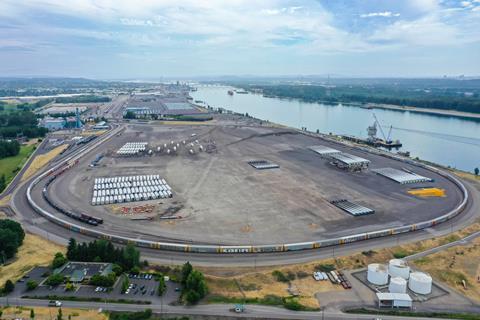The North America’s West Coast project logistics market is on a high, with heavy cargoes in support of the transmission system, solar energy and civil infrastructure particularly bountiful. Offshore wind projects may be in their early stages but the region’s ports as busy boosting their capabilities.

For instance, California aims to generate 25 GW from offshore wind energy projects by 2045 and its first offshore wind auction in December 2022 saw bids totalling USD757 million for five leases. The first turbines are expected in Humboldt Bay, which is slated to produce 1.7 GW. Having signed an agreement with the port of Humboldt Bay in late 2022 to build and operate the planned heavy lift marine terminal to support offshore wind installations, Crowley Wind Services opened its office there in April 2023. In November, the facility was awarded a USD8.7 million government grant, which will be used to fund studies, site design and permitting activities.
US ports are benefitting from federal support and in 2022 the government signed off on USD703 million to fund 41 port infrastructure projects in 23 states. In November 2023, the White House announced another USD653 million for port infrastructure to strengthen supply chains. Among the biggest chunks of that are USD54.2 million for terminal expansion at Tacoma and USD52.6 million towards rail expansion and roadway improvement at Long Beach.
The port of Oakland is getting USD175 million for the realignment of truck access to eliminate congestion. Oakland’s focus is chiefly on the container business, but it has handled some shipments of transformers and tractors, according to a spokesperson.
Bolstered by a USD3.5 million infusion from the Washington state government, the port of Vancouver USA is working on the replacement of its 100-year-old dock at its Terminal 1. Management is looking for parties interested in designing, building, and operating a high-volume facility within its Terminal 5, which is served by an 8,500 ft (2,590 m) rail loop track.
Further down the Columbia River the port of Longview has used a USD16 million grant towards the USD106 million expansion its industrial rail corridor. By adding a six-track rail bed adjacent to the existing two tracks, it can double capacity through the corridor.
In the summer, the port boosted its lifting power and efficiencies with the first two 130-tonne Kalmar Super Gloria reachstackers deployed in the USA.
The port of Everett opened its USD40 million Norton Terminal in December 2022, which nearly doubled its cargo handling footprint. This followed the modernisation of Everett’s South Terminal the year before, which added a full-service berth.
Up in Canada, DP World completed the expansion of its Centerm container facility at the port of Vancouver from 900,000 teu to 1.5 million teu, which included increased berth capacity to handle larger vessels and the addition of more container cranes. The port’s Terminal 2 project to build a fourth container facility next to the Deltaport terminal took a step forward with the environmental approval, but final approval for the plan is still years away, noted Doug Mills, senior account executive, trade development at the Vancouver Fraser Port Authority. Capacity to handle project business at the port’s Fraser Surrey Docks has diminished since the facility started taking on container business. Project moves through the port to Canada’s interior were affected by wildfires and flooding causing landslides in recent years, but interest has been picking up again, Mills noted. “There are a number of polyethylene and polypropylene plants coming online, so we see components to these,” he said. He is not bullish on project cargo flows through the port, though. In the past, many components for the energy sector were built overseas and shipped in through the port, but over the years manufacturing expanded in Alberta.
HLPFI’s full report on the North American West Coast can be seen here.
















